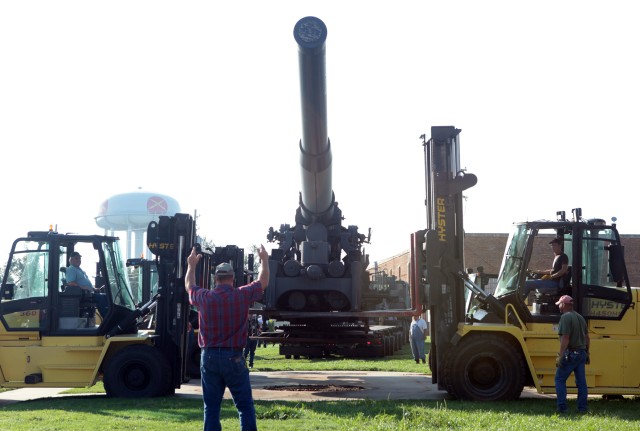
FORT SILL, Okla.--The M65 Atomic Cannon "Atomic Annie" at Fort Sill since 1964 is moving.
"Atomic Annie" moved Sept. 14 from the Cannon Walk at Geronimo and Randolph roads to a staging area here where it will get a new coat of paint. After refurbishing, its home will be at the new Artillery Park next to the Fort Sill Field Artillery Museum.
The towed artillery piece, which fired a 280mm nuclear shell up to 20 miles, was a deterrent during the Cold War, but its technology was quickly overtaken by missiles and rockets, said Towana Spivey, Fort Sill Museum director and curator.
"Atomic Annie," originally nicknamed "Able Annie," was one of 20 guns produced in the early 1950s. In May 1953, two of the guns from Fort Sill were taken to Frenchman Flat test site in Nevada, Spivey said.
Only one of the guns, "Able Annie" was fired in the nuclear tests called Knothole, while "Sad Sack" served as a back up.
"The gun fired a 15-kiloton projectile equal to the bomb that was dropped on Hiroshima," Spivey said.
Immediately after the firing "Able Annie" was rechristened "Atomic Annie."
During the transport of the cannons back to Oklahoma, the identity of them somehow got switched. "Sad Sack," thought to be "Atomic Annie" made it to Fort Sill. The true "Atomic Annie" was sent to an operational unit.
During the 10th anniversary commemorating the firing of "Atomic Annie," it was noticed through serial number identification that the gun was really "Sad Sack," Spivey said.
So what happened to "Atomic Annie'"
The exact locations of atomic guns were classified and they were scattered throughout Europe and Southeast Asia, he said.
A worldwide search began for "Atomic Annie," who was now being referred to as "AWOL Annie," Spivey said. "Only a very few people knew where it was."
The gun was tracked to Houston, New York City and eventually found on duty at a remote site in Germany.
In 1964, while the gun was being retrieved in Germany, "Atomic Annie" and its tractor slid off a mountain road killing two Soldiers and wrecking the prime movers, Spivey said.
That same year, "Atomic Annie" no longer AWOL replaced the imposter at Fort Sill, he said. "Sad Sack" was given to the Smithsonian museums and is part of its collection.

Social Sharing